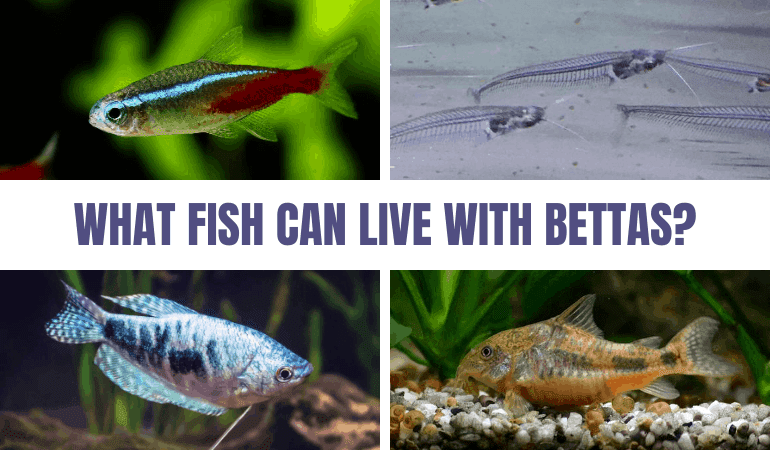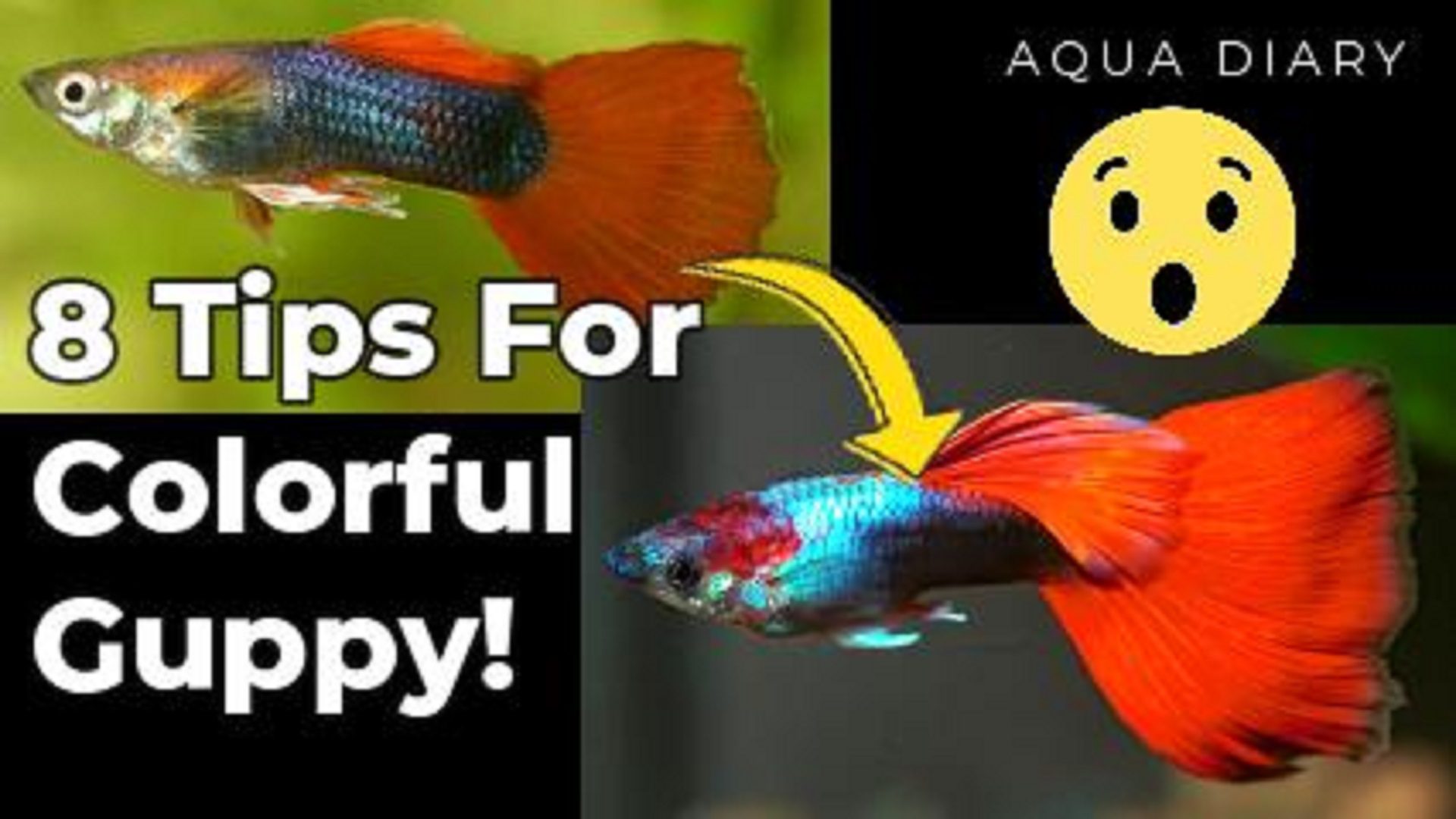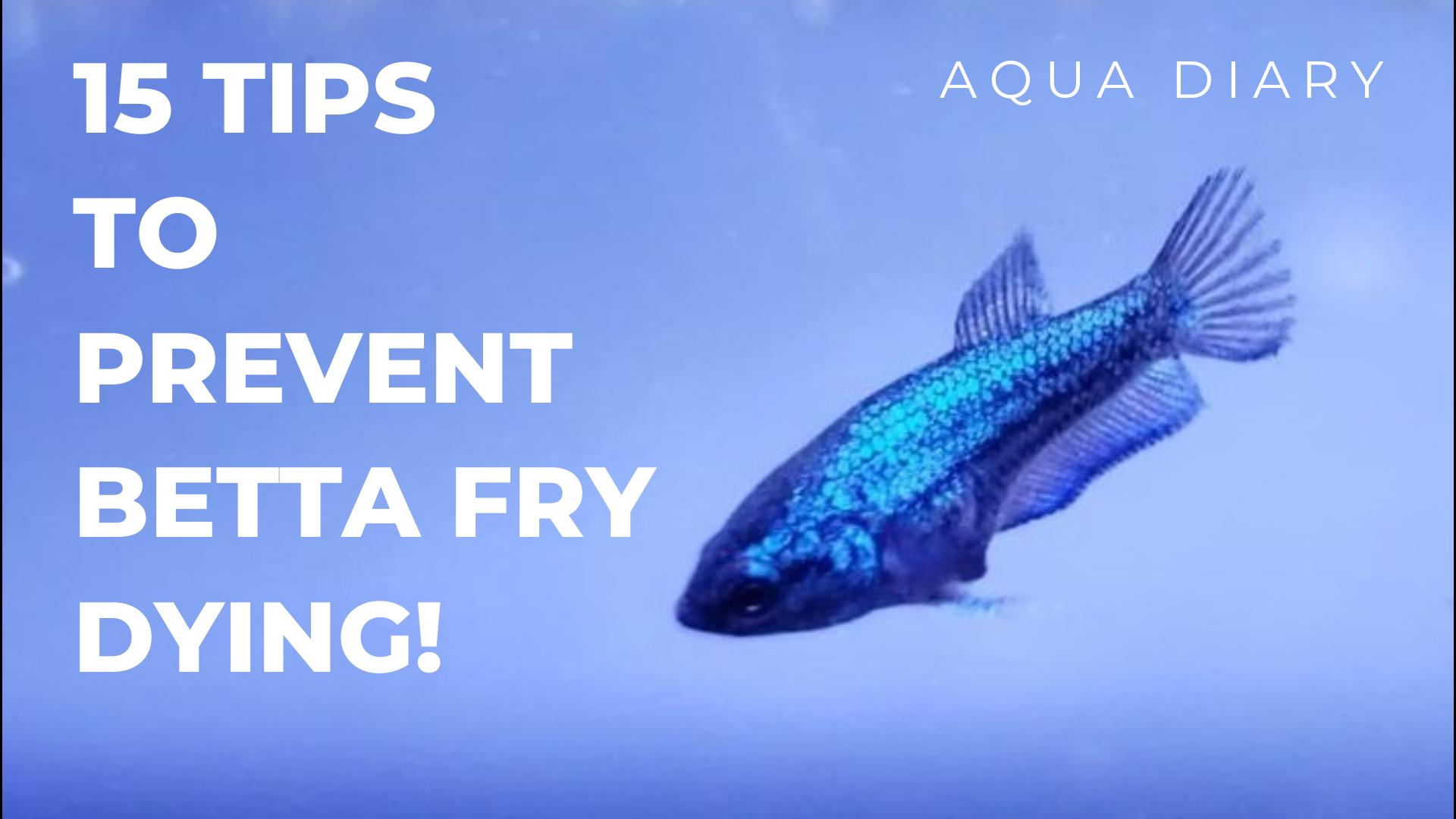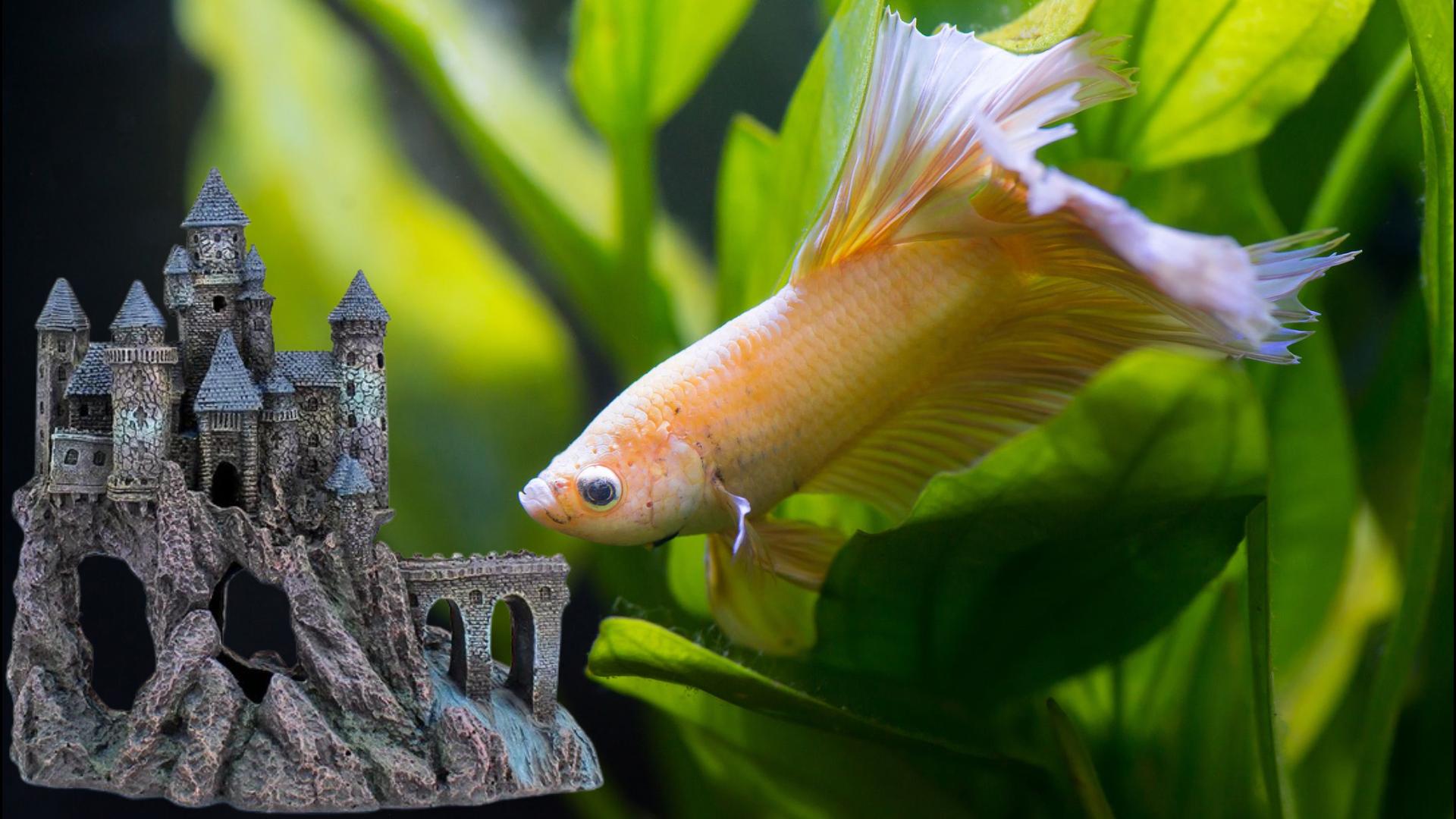Are you looking for Betta fish community tank inspiration? Then you’ve come to the right place! I have compiled a list of the top 10 tank mates for Betta community tank fishes. These tank mates are sure to add color, activity, and excitement to your tank.
Welcome to my post! Betta fish are known for their vibrant colors and flowing fins, and while they are often kept alone, they can actually live happily with other fish. In this post, we’ll explore the best tank mates for Betta fish and how to create a healthy community tank.
Number 10: Neon and Ember Tetras
Neon Tetras are relatively small, growing only to about 1-2 inches in length. This makes them an excellent tank mate for small Betta fish tanks. You’ll also have a lot of action and interest in your tank because they love swimming in schools. They should be kept in schools of at least six to ensure they feel secure, and they prefer a well-planted tank with plenty of hiding spots and caves to retreat to when they feel threatened. They also require a well-maintained tank with stable water parameters to thrive. Overall, if you’re looking for a peaceful and colorful tank mate for your Betta fish, neon Tetras can be an excellent choice.
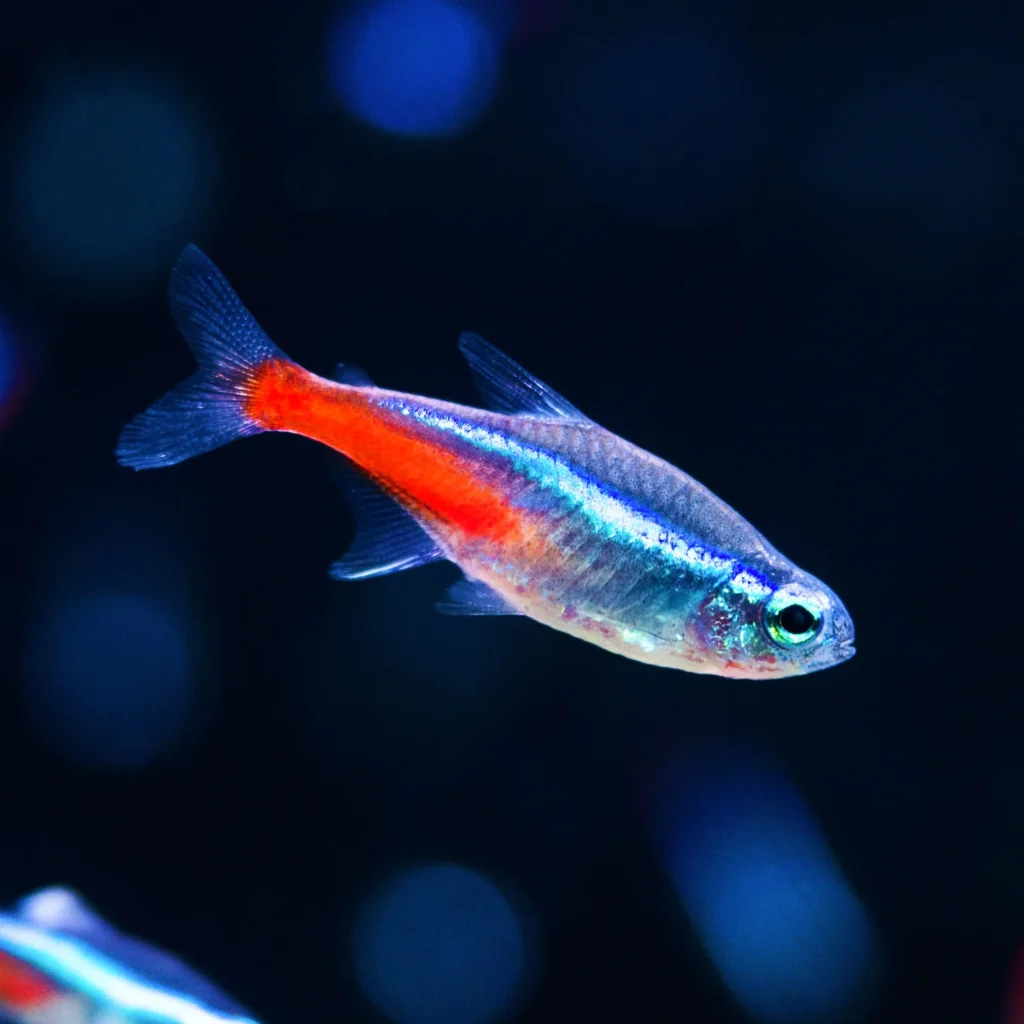
Another option is Ember Tetras. Ember Tetras are similar to Betta fish in that they also prefer heavily planted tanks and enjoy eating brine shrimp. They are also compatible with neon Tetras and will even school with them in the middle of the tank. This helps to reduce any territorial issues that may arise with your Betta fish. Ember Tetras can live for up to four years, which makes them great for community tanks. They are surface feeders, just like Betta fish, making it easy and convenient to feed them both at the same time. While many tetras can coexist peacefully with Betta fish, some species should be avoided, including Serpae tetras, Black skirt tetras, and Silvertip tetras.
Number 9: Corydoras Catfish.
Corydoras Catfish, favored for Betta aquariums, coexist peacefully, not contending for food or space. Their bottom-dwelling nature aids tank hygiene by consuming leftovers. These playful, multicolored fish add visual allure. However, groups of three or more prevent stress, and sandy substrate safeguards their barbels. Thriving in well-planted setups with hideaways, they evade threats. For added care, pygmy corydoras, dull-hued and 1-inch long, offer a better choice against Betta fish.
Number 8: Kuhli Loaches. – Tank mates
Kuhli loaches are peaceful, look amazing, and are helpful for cleaning up uneaten food from the bottom of the tank. Kuhli loaches are nocturnal, which means they are most active during the night when your Betta fish is sleeping. They have a docile temperament and will get along well with your Betta fish. They are shaped like eels and love to disappear into tiny crevices, which can add some interest and movement to your tank. Keep them happy with at least 20 gallons of water, and sand is their favorite substrate since they burrow deep. It’s important to note that other loaches, such as the clown loach, can grow over a foot in length and should be avoided in a Betta fish tank.
Some other suitable loach options to consider are Hillstream loaches, Zebra loaches, and dwarf loaches. Hillstream loaches are often found in fast-moving streams and prefer well-oxygenated water, so they may need a current or air pump in the tank. Zebra loaches are known for their distinctive black and white stripes, and they are active swimmers who enjoy hiding in caves and under decorations. Dwarf loaches are small and peaceful, and they tend to stay close to the bottom of the tank.
Number 7: Cherry and ghost shrimp.
Cherry shrimp are a fantastic addition to any Betta tank. These tiny and colorful crustaceans add a splash of variety to your aquarium and can be a delight to watch as they scuttle around. Thankfully, they’re also peaceful and won’t bother your Betta fish. These shrimp also help keep the water clear by picking up algae and leftover food waste. It’s important to note that your betta may occasionally try to eat them. Therefore, be sure to provide plenty of hiding places and plants for the shrimp to take cover in.
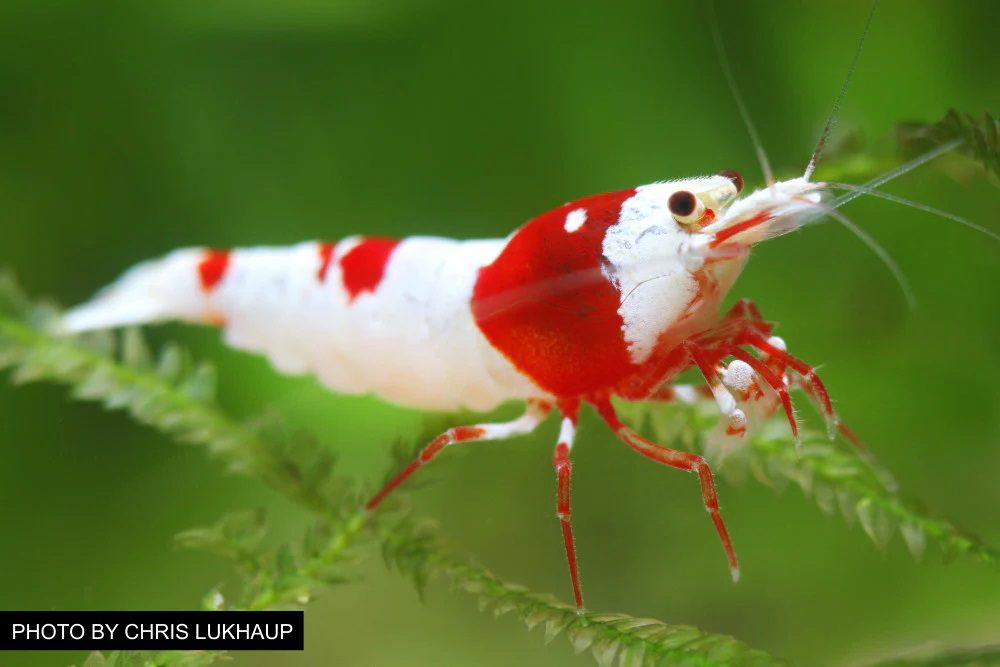
Ghost shrimp are another option for Betta tank mates. These shrimp have translucent bodies, making them harder for your Betta to spot. Like cherry shrimp, they also do a great job of keeping the tank clean by eating algae and waste. One thing to keep in mind with shrimp is that they tend to breed quickly. If you start with a small group of shrimp, you may find yourself with an abundance of them in just a few weeks. But this can be a positive thing if you have a market for them or want to sell them to other aquarium enthusiasts.
Number 6: Harlequin Rasboras
Harlequin rasboras are a popular choice for planted aquariums due to their distinctive appearance and peaceful temperament. This little fish stands out in any aquarium because it has a black triangle on its sides and a golden-orange body. They prefer to live in schools of 5 to 6, making them an excellent choice for a community tank with Betta fish. They are also very fast swimmers, so even if a betta were to become aggressive, the rasboras would be able to outswim them and avoid harm. In addition, larger schools of rasboras will require at least a 10-gallon tank to accommodate their activity.
One potential downside to keeping harlequin rasboras with betta fish is that they swim in the same areas as the betta fish. This can be managed by providing plenty of hiding places and plants in the tank to give each fish its own space.
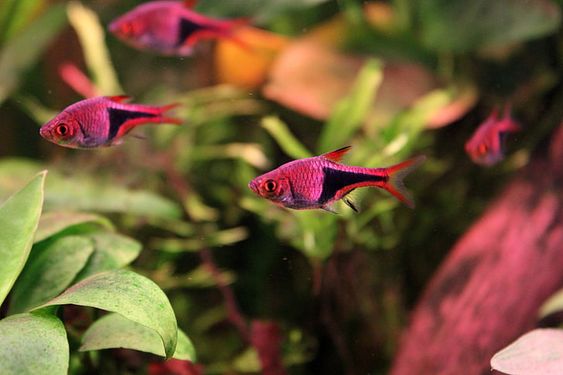
Chili rasbora is another fantastic option. These tiny fish feel right at home for small tanks and can live happily with a single Betta fish. However, it’s important to note that chili rasboras are schooling fish and should always be kept in groups to prevent shyness and stress. A school of chili rasboras, along with your Betta, can create a stunning display in a heavily planted nano tank.
Make sure you’re not making the same mistake as this guy who crammed too many fish in a small tank. If you’re committed to providing your fish with the best possible home.
Number 5: Aquarium snails.
Introducing snails to your Betta tank is a fantastic approach to elevating both the visual appeal and cleanliness of your aquarium. There are several snail options suitable for Betta fish tanks.
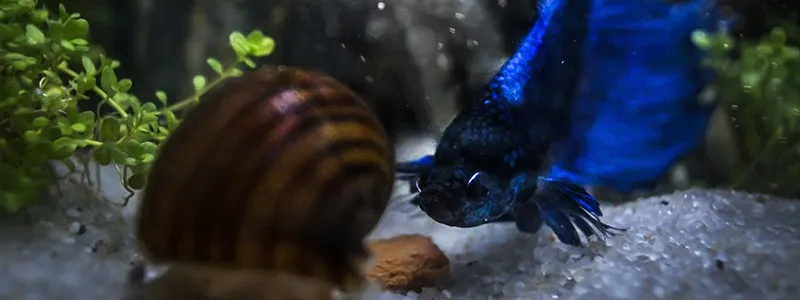
Mystery snails are gentle creatures with resilient shells that shield them from curious or playful Betta fish. Displaying a calm demeanor, they aid in tank hygiene by consuming leftover food and algae. These snails can reach a size of up to 2 inches and live for about a year. Being compatible with live plants, they are fitting for community tanks.
Zebra snails present another appealing choice. These non-aggressive snails require minimal care and contribute to cleanliness by devouring debris. Without posing a threat to Betta fish, they grow to about 1 inch and have a lifespan of roughly two years.
Apple snails, while larger with a potential 6-inch diameter, exhibit docility and peace. Their notable appetite for algae makes them an asset to maintaining tank hygiene. Available in an array of colors, they offer vibrant hues to your setup.
Nerite snails are smaller, around 1 inch, and boast various patterns and colors. Exceptional algae eaters, contribute to a clean environment. Their adaptability to diverse water conditions makes them ideal for beginners.
It’s crucial to note that snails are sensitive to copper, commonly found in Betta medications. If your Betta requires medication, consider moving them to a separate tank while keeping your snails in the main aquarium. This strategy ensures the health of both your Betta and the snails.
Number 4: African Dwarf Frogs – Community tank mates
African dwarf frogs can be great tank mates for Betta fish, as they typically coexist without any issues. They generally ignore each other’s presence. African dwarf frogs are known for producing minimal waste, which can help prevent water parameters from becoming unbalanced.
The main concern when keeping African dwarf frogs and Betta fish together is feeding time. Betta fish are fast swimmers and tend to finish their food before the frogs have a chance to find their own. It’s critical to watch the frogs during feeding time and ensure they are getting their fair share of food. While bettas tend to eat anything they can, it’s important to make sure your frog is getting adequate nutrition as well.
Number 3: Guppy fish – Take mates
Keeping guppy fish in a betta tank can be a suitable option as they are peaceful and non-aggressive fish. Guppies are also livebearers, which means that they give birth to live young instead of laying eggs like some other fish species. This trait makes them a good option for adding some diversity to your Betta tank. They are also relatively easy to care for, making them a great option for beginners. Guppies prefer a water temperature of around 75-82°F and a pH level of 7.0-8.0. These conditions are similar to what Betta fish require, so they can coexist comfortably in the same tank.
One potential issue when keeping guppy in a Betta tank is that Bettas may mistake guppy fins for another Betta’s fins and become aggressive towards them. This can be avoided by choosing guppy breeds with shorter fins like feeder guppy or keeping both species in a large enough tank where they can establish their territories.
I have compiled this list based on my experience with community tank fish for betta fish. I also believe there are different opinions. Please tell me your most and least favorite community tank fish options in the comments below.
Number 2: Platyfish
Vibrant and lively Platyfish are wonderful companions for Bettas. Their peaceful nature and non-nipping behavior add vitality to your tank. Easy care suits beginners, tolerating a broad pH range, and favoring neutral to alkaline conditions. Similar to mollies, Platyfish are schooling fish with inconspicuous tails, evading Betta’s interest. This trait makes them a perfect match for Betta tanks, coexisting without fin-related conflicts. Yet, their shared habitat can lead to spatial competition. For a serene and colorful tank partner, Platyfish harmonizes well with Bettas, offering an ideal choice.
Number 1: Otocinclus catfish
Otocinclus catfish could be a great option. They don’t bother betta fish and also keep the tank clean. These small catfish grow to just 2 inches and have a big appetite for algae, making them the perfect algae eaters for mature aquariums. However, it’s important to note that they should not be added to very small or new aquariums where there won’t be enough food for them. Otos are peaceful fish and won’t compete with your Betta for food. They’re perfect tank mates for many of the same reasons as cory cats. They remain on the bottom of the tank, keeping the substrate clean, and travel in groups, making it harder for betta to bother them. However, Otos do need plenty of plants to hide in and must be in groups, which can be challenging to accommodate in smaller tanks.
There are also other community fish options to consider, such as Bamboo Shrimp, Molly Fish, Amano Shrimp, and Minnows. No matter what fish you choose, you have to make sure they’re relaxed and non-territorial. If they fight with your Betta often, you’ll need to remove them. It’s crucial to ensure that you have the appropriate tank size when you are building a community fish tank. A general rule of thumb is that each inch of fish requires a gallon of water. It’s important to figure out how many fish you’re going to keep based on the size of your tank. Overall, you’ll have plenty of options to build a stunning community tank where your Betta fish can take center stage!
These well-known for their bullying behaviors. Let’s take a look at the top 10 freshwater aquarium bully fishes and what you can do to prevent their bullying. We are talking about fish predators & fishes that eat other fishes like Piranhas, Silver Arowana, or retail catfish which have no business in your community aquarium. to expect such fish to behave well in a community is unreasonable. Here we begin with, some of the most popular freshwater aquaria bullies and tips to handle them peacefully in the community tank.
1. Tiger Barb
The tiger barb is one of my favorite fish across fish keepers. Tiger barbs have the perfect mix of activity, bright color, and strong markings to make them attractive. Tiger barbs are named for their orange-and-black strips, but some aquarium hobbyists might say their name fits their tiger-like behavior. I can tell you that this is one of the fish that hobbyists most complain about their bullying behavior. These fish are known for being fin nippers and bullying more passive species. They can get a little aggressive in the community tank unless you keep them properly. As a result, proper planning is essential if you want to keep them in a community environment.

The key to keeping tiger barbs properly is to keep them in a group with at least 6 of them. The hobbyists who have problems with nippy tiger barbs usually have only one or two of them. Keeping a family of Tiger Barbs together can produce a stunning show in your tank. As long as tiger barbs can shoal, their fin nipping and aggression will be targeted toward their group and not toward your other fish. They chase each other around all day long, taking little nips to set up a pecking order. No damage is done because the aggression is spread evenly through the group.
2. Red-Tailed Shark – Freshwater Aquarium Bully fish
The Red Tail Shark is Highly active and naturally curious, these fish spend most of their time darting back and forth at the bottom of the tank. They like to investigate every nook and cranny of the aquarium. Visually, these fish are quite simple. However, it’s that simplicity that makes them beautiful! The entire body is covered with dark black. The only exception is the tailfin, which is a vibrant red. Many aquarium hobbyists say Red Tail Shark is not a good option for a community tank. But, As long as you are careful about what fish you keep with red-tailed sharks and provide plenty of space, they can live peacefully with other fishes.

However, there are rules. First off, keep no more than one red-tailed or similar shark in your aquarium. They just do not get along with each other — it will guarantee a fight. The red-tailed shark is also highly territorial. As it grows, so will its territory. This may be a problem in small tanks, with the fish trying to drive other fish out of their range, and there is nowhere for them to run.
3. Betta Fish – Freshwater Aquarium Bully fish
The betta or Siamese fighting fish are very territorial. but this fish can mix very well into a community. There are just a few rules. First, keep no more than one male betta per tank — males do fight to death. Females pick on each other too, though not so harshly. Also, males may kill females that are unwilling to breed.

Bettas are slow swimmers in general. like to stay quiet till the fight starts. They will be very aggressive when you put them with 2 males or some other fish with a similar color. However, Betta is very easy to care for; and not highly demanding. They do live at 76-82’F water temperature. Keep in mind. Avoid mixing them with species that share the same territories, such as gouramis. Finally, do not mix bettas with fin-nippers such as the tiger barbs, Bucktooth Tetra, or other fishes. The long fins are too tempting, and the slow speed of the bettas makes it too easy. Bettas are more at risk from the other fish in the tank than the other way around.
4. Convict Cichlid
Convict Cichlids are one of the most popular species in the Cichlid family. They’re a beautiful species that loves to stay active. The convict cichlid is known for its striking appearance – it has a silver-gray body with dark vertical black stripes. They create a look that’s similar to prisoner uniforms, which is why they have the name Convict Cichlid. In the right lighting, you might also notice some random pops of color. The fins take on an iridescent sheen, creating a sparkling spectrum of colors.
The convict is relatively peaceful—for a cichlid—and gets along with most fish. Convict cichlids are typically classified as aggressive but the problem only occurs when they are breeding. These cichlids become incredibly territorial during breeding because they care for and raise their fry – if there are other fish in the tank, they will likely be considered a threat. A pair of convict cichlids can do perfectly fine in a tank on their own or a single convict cichlid in a community tank. They do best in large tanks with plenty of hiding places. Rocks, driftwood, and artificial caves are essential for helping the fish feel safe.
5. Blue Gourami – Freshwater Aquarium Bully fish
The blue or three-spot gourami is a very popular fish but is often reported to be too aggressive. While most gouramis are very peaceful by nature, this species tends to be a little aggressive – but only around other gouramis. All gouramis are territorial. They like to claim a section of the tank, usually near the surface at the edge of some plants, and defend it. The blue gourami is usually tolerant of the other fish. So, keeping just one gourami in a community helps them get along well with everyone. Also, this fish isn’t always blue. Gold, opaline, platinum, and lavender gouramis are different color varieties of the Gouramis fish.

It tends to become a problem when there is more than one gourami in the aquarium. They see each other as competitors for the same territories, competitors for mates, or as prospective mates. The behavior is similar to that of their relative, the betta. In large aquariums, it’s less of a problem because there is more room for fish to run and hide.
Some aquarium hobbyists suggest adding enough gouramis so that none can claim or defend a territory. So, they give up and get along. It’s why the fish don’t fight much in pet store tanks. However, it’s an unnatural way for gouramis to live and is not the best way to keep them.
We do watch the blog till the end and post your comments in case of any other questions. We constantly check the comments section and reply to all questions received.
6. Chinese Algae-Eater
The Chinese algae-eater is a fraud. It doesn’t come from China, and it barely eats algae. Worse, it often feeds off the body slime of other fish, injuring or killing them. Many hobbyists end up with it as the only fish in their tank without knowing why. Who would suspect an “algae-eater” to be anything but harmless? I wish dealers would stop stocking this fish. If you have a Chinese algae-eater, there are only two things you can do to prevent it from bothering your other fish. Feed it very well to distract it, or get rid of it.
7. Skunk Loach – Freshwater Aquarium Bully fish
The skunk loach also sells under several other names: skunk botia, Hora’s loach, dwarf skunk loach, and others. It’s a cute little fish, growing to about 4 inches. Sadly, it often becomes nippy. Many hobbyists have no trouble with it at all if it is kept well-fed and fat. Others find it to be nothing but a nippy sociopath. If your fish causes trouble, try feeding it heavier with sinking pellets. Should that not work, there will be no choice but to remove the fish from the tank.
8. Angelfish
Who would ever expect an angel to be a devil? In most cases, angelfish are indeed angels. They mix very well in a community aquarium—as long as you don’t mix them with fish that will nip their long, delicate fins. And I highly recommend these fish—angelfish is an all-time favorite of almost every hobbyist.

However, angelfish are cichlids. Like other cichlids, they are territorial. They will become much more protective of their territory, especially toward other angelfish. Submissive tankmates may be bullied away from food, stop growing, and even starve. If this happens, you can do two things. First, jump for joy that you have pair-bonded angels. They will almost certainly spawn at the next water change. It’s great fun to watch them breed. Second, consider moving the other angelfish into another aquarium where they won’t disturb the breeding pair.
9. Oscar Fish – Freshwater Aquarium Bully fish
One of the most identifiable Cichlid species in the world is the Oscar. Also known as the Velvet Cichlid, these fish are incredibly popular in the aquarium trade. Mostly black, the fish’s body is accented with colors of orange, red, and gray. These colors combine to create a truly unique appearance that you have to see to appreciate!

For the most part, Oscar Cichlids aren’t too difficult to care for. They adapt well to most conditions as long as you stick within the accepted parameters. You won’t even need any special filtration or current generators. These fish are easy to feed as well. Unlike other fish on this list, Oscars aren’t pure carnivores. They will accept processed foods and nibble on plants. The main issue you might encounter is its temperament. Oscar Cichlids are known bullies who will attack and eat any vulnerable fish. If you want to add some tank mates, make sure that you’re getting aggressive fish that can hold their own against the Oscar.
10. Bucktooth Tetra

The Bucktooth Tetra is an attractive fish that will add a lot of shimmer to your aquarium. This fish is covered in silvery gray. Part of the body is semi-transparent, which only makes the shiny portion pop out even more. Two large black dots are the species’ signature markings. One dot is on the center of the body while the other is on the base of the tail. You will also notice hints of yellow on the top of the body and subtle splashes of red on the fins.
Bucktooth Tetras have some unique behavioral quirks. When kept with other fish, they’re notorious for ripping off fish scales and eating them! Needless to say, keeping them with other types of fish that have big fins is not recommended. It’s best to keep them in groups of at least 12. Smaller groups may result in battles for dominance, so the more fish the better!
What is your favorite bully fish? Let us know in the comment section below.
If you have ever kept a Betta fish, you know how picky they can be about their tank mates. They are known for their aggressive behavior, and you have to be very careful when introducing them to new fish. If you add the wrong fish, your Betta could become stressed, injured, or even killed. Today, we’ll discuss the Bad Fish for Betta Community Tank.
So, what fish should you avoid adding to your Betta tank? Keep watching to find out!
Goldfish
The first fish on our “NOPE list” is Goldfish. Goldfish are messy, and they produce a lot of waste, which can be harmful to Betta fish. Goldfish also require a different temperature and pH level than Betta fish. They prefer cooler water, whereas Betta fish require warmer water. Housing these two fish together can lead to stress, disease, and even death for your Betta. Therefore, it’s a terrible idea to keep them together in the same aquarium.
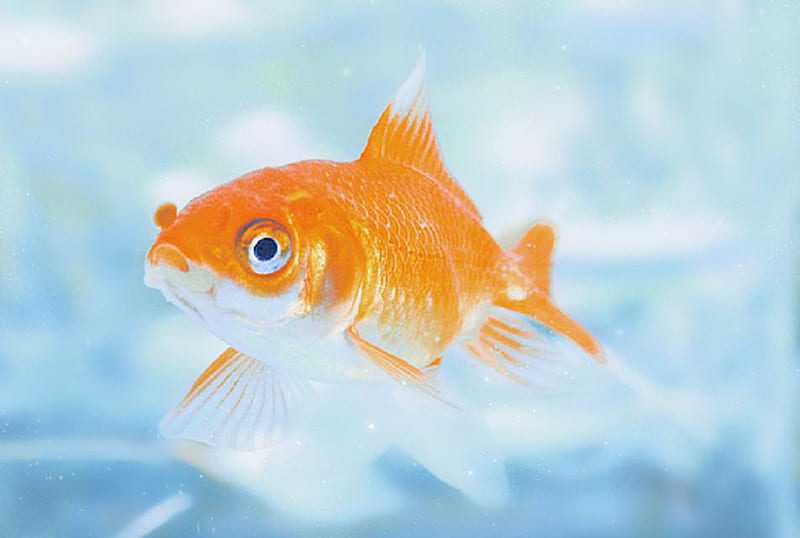
Additionally, goldfish are known to be active and fast-swimming fish that can outcompete bettas for food, causing the bettas to become malnourished. Goldfish are also notorious for producing a lot of waste, which can lead to poor water quality in the tank. This can be harmful to both goldfish and bettas, but bettas are particularly sensitive to poor water conditions.
Cichlids
Another fish that shouldn’t be added to a Betta tank is Cichlids. Cichlids are known for their aggressive behavior, which can be dangerous for your Betta. Also, Cichlids prefer a higher pH level, while Betta fish require a lower pH level. Therefore, it’s not a good idea to keep them together. This one of the Bad Fish for Betta Community Tank specially with betta fish.
Gourami
Gourami are part of the same family as Betta fish, but they don’t get along well together. They are both aggressive fish and have a tendency to pick fights with each other. This can lead to injury, stress, and disease, which can be fatal to your Betta. So, it’s better to avoid keeping them together.
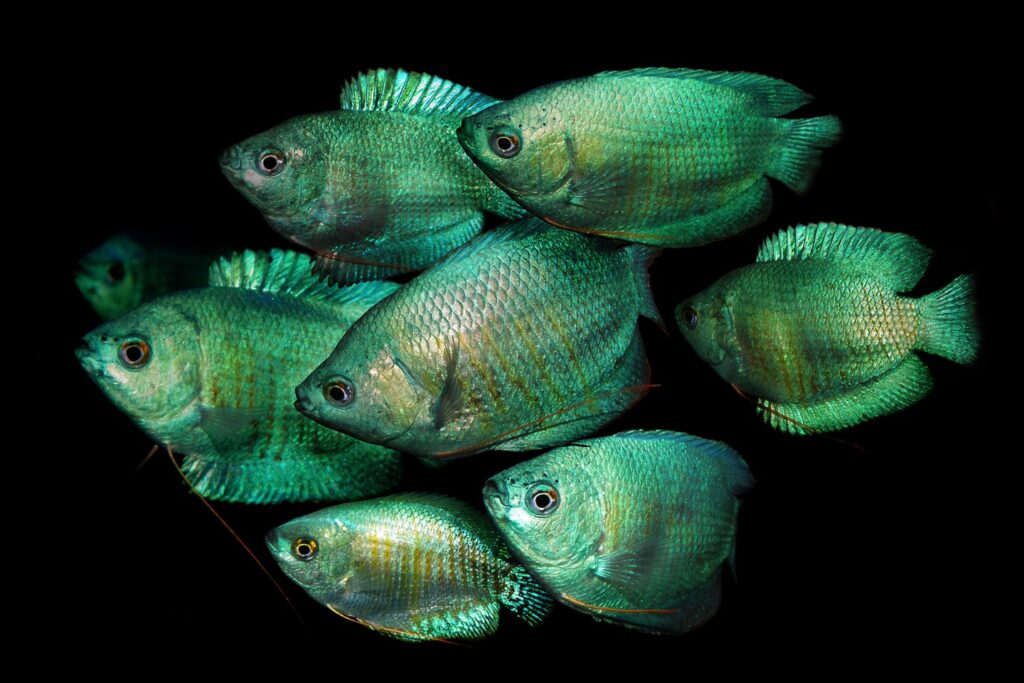
Tiger Barbs
Tiger Barbs are highly entertaining fish, but they are not suitable for a Betta tank. They have a habit of attacking and shredding the fins of Betta fish. Betta fish are not strong swimmers, and they can’t escape from the Tiger Barbs’ aggressive behavior. Therefore, it’s not recommended to keep them together. These fish looks cool, but specialist at fin nipping which tag them as Bad Fish for Betta Community Tank.
Chinese Algae Eaters
Chinese Algae Eaters are known for their aggressive behavior and have a habit of attacking other fish in the tank. They are also known for sucking on other fish, which can be harmful to your Betta. This can lead to stress and disease, which can be fatal to your Betta. Therefore, it’s better to avoid keeping them in the same tank.
Other Betta Fish
Finally, you should avoid keeping other Betta fish with your current Betta unless you’re building a sorority. Betta fish are highly territorial, and they will fight to establish their dominance. This can lead to injury and stress for your Betta. Therefore, it’s better to avoid keeping them together unless you’re building a sorority.
In conclusion, Betta fish are beautiful and fascinating creatures, but they require careful consideration when choosing tank mates. Adding the wrong fish to their tank can lead to injury, stress, and even death. Therefore, it’s better to avoid adding the fish on the “NOPE list” to your Betta tank. Instead, research and choose tank mates that are compatible with your Betta’s needs. Remember, a happy and healthy Betta fish is a beautiful fish!

